AI and the Legal System: A Double-Edged Sword edit

The legal system, steeped in tradition and precedent, is slowly but surely being reshaped by the transformative power of Artificial Intelligence (AI). AI offers a vast array of tools, but its impact is a double-edged sword, presenting both exciting opportunities and significant challenges. Revolutionizing Legal Workflows: Efficiency on Steroids: AI can automate repetitive tasks like legal research, contract analysis, and due diligence. Imagine a world where lawyers can instantly access summaries of relevant case law or have AI spot inconsistencies in contracts, freeing them to focus on complex legal issues and client strategy. The Power of Prediction: AI can analyze vast datasets to predict the likelihood of winning a case, estimate settlement costs, and identify legal risks. This empowers lawyers to provide more informed advice and develop data-driven litigation strategies. Justice for All?: AI-powered legal chatbots and online legal document generators can provide basic lega...
















